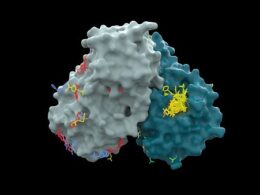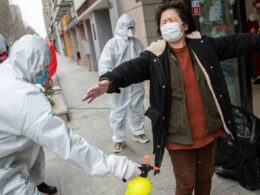The “new normal” requires recognizing that SARS-CoV-2 is but one of several circulating respiratory viruses that include influenza, respiratory syncytial virus (RSV), and more.
JAMA Network
Ezekiel J. Emanuel, MD, PhD1; Michael Osterholm, PhD, MPH2; Celine R. Gounder, MD, ScM3
January 6, 2022
aegon life
As the Omicron variant of SARS-CoV-2 demonstrates, COVID-19 is here to stay.
In January 2021, President Biden issued the “National Strategy for the COVID-19 Response and Pandemic Preparedness.”
As the US moves from crisis to control, this national strategy needs to be updated.
Policy makers need to specify the goals and strategies for the “new normal” of life with COVID-19 and communicate them clearly to the public.
SARS-CoV-2 continues to persist, evolve, and surprise.
In July 2021, with vaccinations apace and infection rates plummeting, Biden proclaimed that “we’ve gained the upper hand against this virus,” and the Centers for Disease Control and Prevention (CDC) relaxed its guidance for mask wearing and socializing.1
By September 2021, the Delta variant proved these steps to be premature, and by late November, the Omicron variant created concern about a perpetual state of emergency.
In delineating a national strategy, humility is essential.
The precise duration of immunity to SARS-CoV-2 from vaccination or prior infection is unknown.
Also unknown is whether SARS-CoV-2 will become a seasonal infection; whether antiviral therapies will prevent long COVID; or whether even more transmissible, immune-evading, or virulent variants will arise after Omicron.
The precise duration of immunity to SARS-CoV-2 from vaccination or prior infection is unknown.
Another part of this humility is recognizing that predictions are necessary but educated guesses, not mathematical certainty.
The virus, host response, and data will evolve. Biomedical and public health tools will expand, along with better understanding of their limitations.
The incidence of SARS-CoV-2, vaccination rates, hospital capacity, tolerance for risk, and willingness to implement different interventions will vary geographically, and national recommendations will need to be adapted locally.
It is imperative for public health, economic, and social functioning that US leaders establish and communicate specific goals for COVID-19 management, benchmarks for the imposition or relaxation of public health restrictions, investments and reforms needed to prepare for future SARS-CoV-2 variants and other novel viruses, and clear strategies to accomplish all of this.
Redefining the Appropriate National Risk Level
The goal for the “new normal” with COVID-19 does not include eradication or elimination, eg, the “zero COVID” strategy.2
Neither COVID-19 vaccination nor infection appear to confer lifelong immunity.
Current vaccines do not offer sterilizing immunity against SARS-CoV-2 infection. Infectious diseases cannot be eradicated when there is limited long-term immunity following infection or vaccination or nonhuman reservoirs of infection.
The majority of SARS-CoV-2 infections are asymptomatic or mildly symptomatic, and the SARS-CoV-2 incubation period is short, preventing the use of targeted strategies like “ring vaccination.”
Even “fully” vaccinated individuals are at risk for breakthrough SARS-CoV-2 infection. Consequently, a “new normal with COVID” in January 2022 is not living without COVID-19.
Neither COVID-19 vaccination nor infection appear to confer lifelong immunity.
The “new normal” requires recognizing that SARS-CoV-2 is but one of several circulating respiratory viruses that include influenza, respiratory syncytial virus (RSV), and more.
COVID-19 must now be considered among the risks posed by all respiratory viral illnesses combined.
Many of the measures to reduce transmission of SARS-CoV-2 (eg, ventilation) will also reduce transmission of other respiratory viruses.
The “new normal” requires recognizing that SARS-CoV-2 is but one of several circulating respiratory viruses that include influenza, respiratory syncytial virus (RSV), and more.
Thus, policy makers should retire previous public health categorizations, including deaths from pneumonia and influenza or pneumonia, influenza, and COVID-19, and focus on a new category: the aggregate risk of all respiratory virus infections.
Thus, policy makers should retire previous public health categorizations … … and focus on a new category: the aggregate risk of all respiratory virus infections.
What should be the peak risk level for cumulative viral respiratory illnesses for a “normal” week?
Even though seasonal influenza, RSV, and other respiratory viruses circulating before SARS-CoV-2 were harmful, the US has not considered them a sufficient threat to impose emergency measures in over a century.
People have lived normally with the threats of these viruses, even though more could have been done to reduce their risks.
The appropriate risk threshold should reflect peak weekly deaths, hospitalizations, and community prevalence of viral respiratory illnesses during high-severity years, such as 2017–2018. 3
That year had approximately 41 million symptomatic cases of influenza, 710 000 hospitalizations and 52 000 deaths.4
In addition, the CDC estimates that each year RSV leads to more than 235 000 hospitalizations and 15 000 deaths in the US.3
This would translate into a risk threshold of approximately 35 000 hospitalizations and 3000 deaths (<1 death/100 000 population) in the worst week.
Today, the US is far from these thresholds.
For the week of December 13, 2021, the CDC reported the US experienced more than 900 000 COVID-19 cases, more than 50 000 new hospitalizations for COVID-19, and more than 7000 deaths.5,6
The tolerance for disease, hospitalization, and death varies widely among individuals and communities.
What constitutes appropriate thresholds for hospitalizations and death, at what cost, and with what trade-offs remains undetermined.
This peak week risk threshold serves at least 2 fundamental functions.
This risk threshold triggers policy recommendations for emergency implementation of mitigation and other measures.
In addition, health systems could rely on this threshold for planning on the bed and workforce capacity they need normally, and when to institute surge measures.
Rebuilding Public Health
To cope with pandemic, and eventually, endemic SARS-CoV-2 and to respond to future public health threats requires
- deploying real-time information systems,
- a public health implementation workforce,
- flexible health systems,
- trust in government and
- public health institutions, and
- belief in the value of collective action for public good.7,8
First, the US needs a comprehensive, digital, real-time, integrated data infrastructure for public health.
As Omicron has reemphasized, the US is operating with imprecise estimates of disease spread, limited genomic surveillance, projections based on select reporting sites, and data from other countries that may not be generalizable. These shortcomings are threatening lives and societal function.
The US must establish a modern data infrastructure that includes real-time electronic collection of comprehensive information on respiratory viral infections, hospitalizations, deaths, disease-specific outcomes, and immunizations merged with sociodemographic and other relevant variables.
The public health data infrastructure should integrate data from local, state, and national public health units, health care systems, public and commercial laboratories, and academic and research institutions.
Using modern technology and analytics, it is also essential to merge nontraditional environmental (air, wastewater) surveillance data, including genomic data, with traditional clinical and epidemiological data to track outbreaks and target containment.
Second, the US needs a permanent public health implementation workforce that has the flexibility and surge capacity to manage persistent problems while simultaneously responding to emergencies.
Data collection, analysis, and technical support are necessary, but it takes people to respond to crises. This implementation workforce should include a public health agency–based community health worker system and expanded school nurse system.
A system of community public health workers could augment the health care system by testing and vaccinating for SARS-CoV-2 and other respiratory infections; ensuring adherence to ongoing treatment for tuberculosis, HIV, diabetes, and other chronic conditions; providing health screening and support to pregnant individuals and new parents and their newborns; and delivering various other public health services to vulnerable or homebound populations.
School nurses need to be empowered to address the large unmet public health needs of children and adolescents. As polio vaccination campaigns showed, school health programs are an efficient and effective way to care for children, including preventing and treating mild asthma exacerbations (often caused by viral respiratory infections), ensuring vaccination as a condition for attendance, and addressing adolescents’ mental and sexual health needs. School clinics must be adequately staffed and funded as an essential component of the nation’s public health infrastructure.
Third, because respiratory infections ebb and flow, institutionalizing telemedicine waivers, licensure to practice and enable billing across state lines, and other measures that allow the flow of medical services to severely affected regions should be a priority.
Fourth, it is essential to rebuild trust in public health institutions and a belief in collective action in service of public health.7
Communities with higher levels of trust and reciprocity, such as Denmark, have experienced lower rates of hospitalization and death from COVID-19.7 Improving public health data systems and delivering a diverse public health workforce that can respond in real time in communities will be important steps toward building that trust more widely.
Conclusions
After previous infectious disease threats, the US quickly forgot and failed to institute necessary reforms.
That pattern must change with the COVID-19 pandemic. Without a strategic plan for the “new normal” with endemic COVID-19, more people in the US will unnecessarily experience morbidity and mortality, health inequities will widen, and trillions will be lost from the US economy.
This time, the nation must learn and prepare effectively for the future.
This time, the nation must learn and prepare effectively for the future.
The resources necessary to build and sustain an effective public health infrastructure will be substantial.
Policy makers should weigh not only the costs but also the benefits, including fewer deaths and lost productivity from COVID-19 and all viral respiratory illnesses.
Indeed, after more than 800 000 deaths from COVID-19, and a projected loss of $8 trillion in gross domestic product through 2030,8 these interventions will be immensely valuable.
Published Online: January 6, 2022. doi:10.1001/jama.2021.24282
References
See the original publication
About the authors & affiliations
Ezekiel J. Emanuel, MD, PhD1; Michael Osterholm, PhD, MPH2; Celine R.
1Perelman School of Medicine and The Wharton School, University of Pennsylvania, Philadelphia
2Center for Infectious Disease Research and Policy, University of Minnesota, Minneapolis
3Grossman School of Medicine, New York University, New York, New York
Conflict of Interest Disclosures: Dr Emanuel reported personal fees, nonfinancial support, or both from companies, organizations, and professional health care meetings and being a venture partner at Oak HC/FT; a partner at Embedded Healthcare LLC, ReCovery Partners LLC, and COVID-19 Recovery Consulting; and an unpaid board member of Village MD and Oncology Analytics. Dr Emanuel owns no stock in pharmaceutical, medical device companies, or health insurers. No other disclosures were reported.
Additional Information: Drs Emanuel, Osterholm, and Gounder were members of the Biden-Harris Transition COVID-19 Advisory Board from November 2020 to January 2021.
Originally published at https://jamanetwork.com












